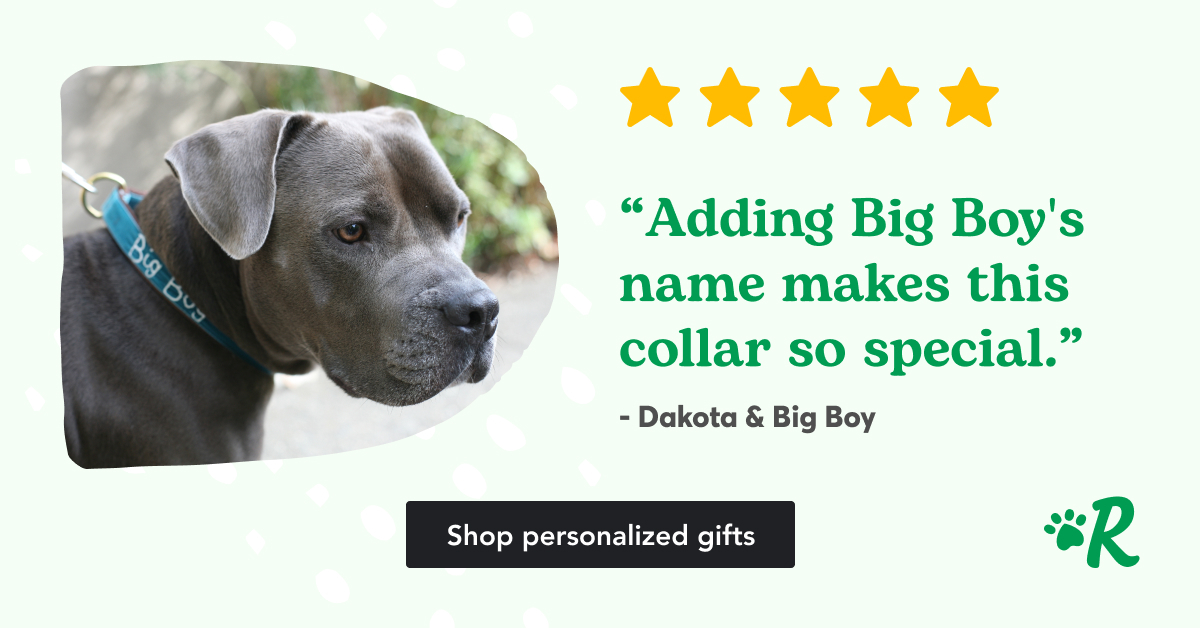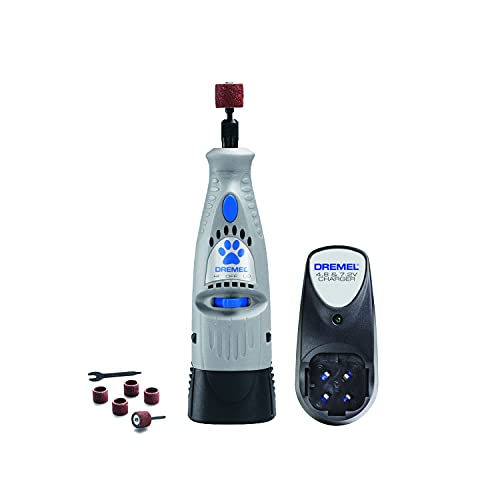- This post contains affiliate links. Read more here.
- Not a substitute for professional veterinary help.
For many dogs, a nail trim is akin to torture. Just the sound of the clippers can send them (and their owners) into a panic. Unfortunately, that means that many dogs don’t get trimmed as often as they should—and that’s a problem. Short nails aren’t just a style choice for dogs, since too-long talons can cause discomfort and paw injuries. The search for an answer to painful trims has led many pet parents to dog nail grinders.
Grinders have emerged as an alternative to the traditional clippers that pinch and cut a dog’s nail. But how exactly do they work, and can they make the process more pleasant for pups and their owners alike? We tested the Dremel 7300-PT Cordless Dog Nail Grinding Tool to find out.
Meet Logan, Our Test Subject

Logan is ready for his paw-dicure.
My dog Logan is a beautiful black Labrador retriever with a sweet disposition and a shiny coat. His nails are, naturally, as dark as his hair.
If you’ve ever tried to trim black dog nails, you know that it’s a challenge. You can’t easily see the quick—the tender part that’s alive with nerves—making it hard to trim the nails to the right length safely. Too far, and you cut into the quick, causing pain and bleeding. Too short, and you’ll have to trim again and again, which gets more difficult the more you work at it.
Rather than risk it ourselves, we’ve been sending Logan to the groomer for his regular trims, but that became more challenging during the COVID-19 pandemic when they stopped accepting walk-ins. I was thinking about alternative at-home options for Logan’s regular paw-dicure when the Dremel grinder came my way.
Why Dog Nails Need to Be Trimmed—and How Often to Do It
When a dog’s nails get too long, it can impact the way that they walk and run, which can even lead to arthritis over time. Long nails also risk breaking, which can cause paw injuries.
Experts recommend that you trim your dog’s nails once a month or so. Anyone with hard flooring like wood or tile knows the distinctive “clicking” sound of a dog’s nails on the floor. That clicking means that it’s time for a trim. If your dog’s nails are overgrown, you may need to trim more frequently at first, taking off just a little at a time.
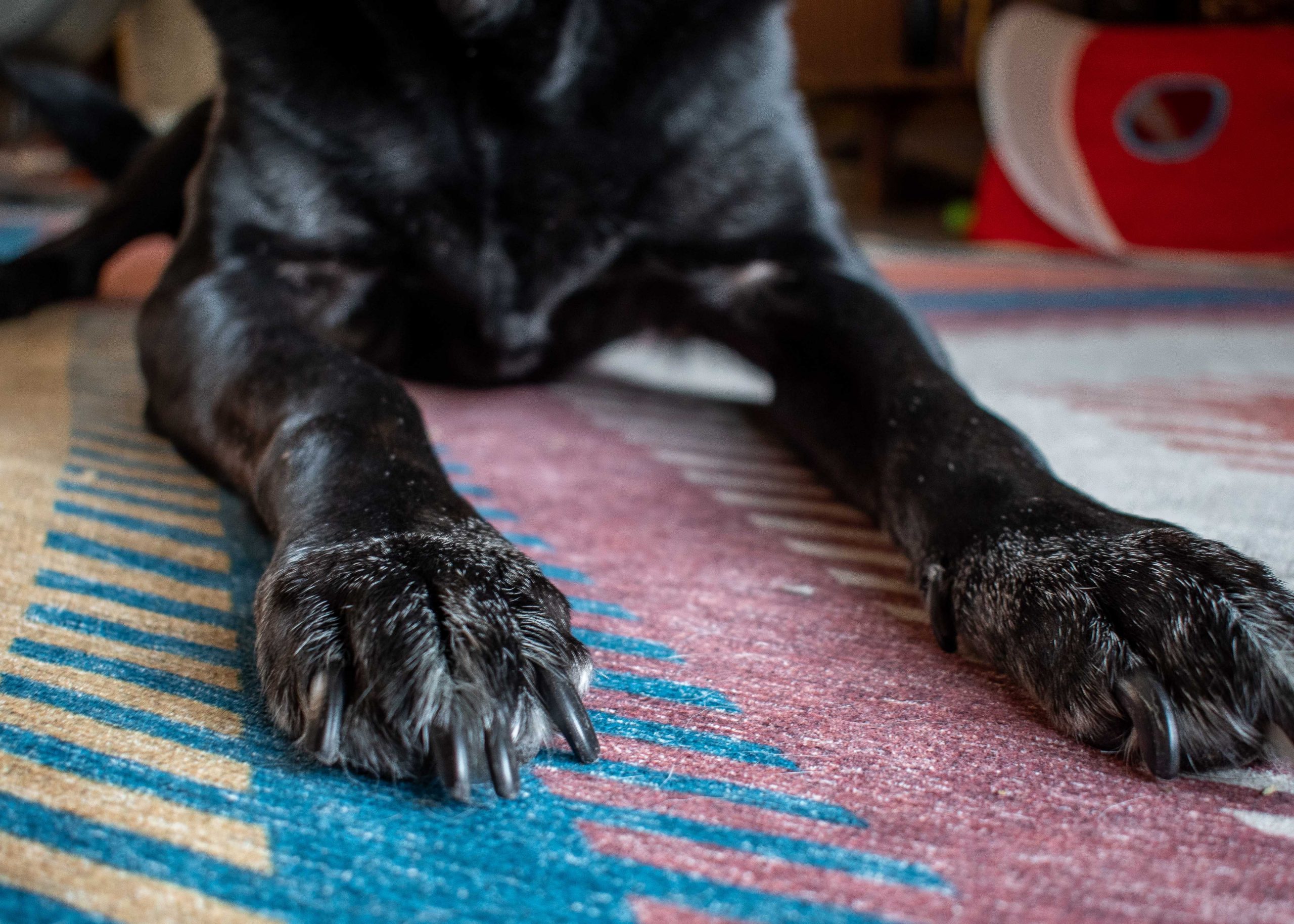
Logan’s too-long nails, ready for a trim.
Benefits of Nail Grinding
Dogs’ toenails are very different from human nails. They’re made from two primary layers: a hard outer shell made of keratin and a soft inner layer called the quick.
Traditional nail clippers work by pinching and then cutting through the nerveless keratin part of a dog’s nail. This can be uncomfortable for the dog, and it can also leave rough, scratchy edges that catch on fabric and cause damage to floors and furniture.
In my house, nail-trim day usually requires both humans (even for the smaller dog, a 30-pound Terrier mix) and creative contortions of humans and dogs to hold our pups in place while simultaneously finding a good angle to trim from. Even with treats, it’s a challenging process all around.
A dog nail grinder works differently. A typical grinder is a rotary tool with an extended tip that spins. A rough surface attached to the spinning end sands the nail down gradually, smoothing as it goes.
The slower, steadier process offers greater control, allowing you to be more precise and intentional with your trim. That’s a huge advantage for pet parents with dark-nailed pups. On light-colored nails, you can usually see the quick through the outer layer of keratin—it’s filled with nerves and blood vessels, which make it appear pink. In dark-colored nails, however, the quick isn’t visible, and it’s easy to accidentally trim too far. Because grinding is slower and gentler, it’s a lot easier to stop short of the quick.
Even for pups with light-colored nails, grinding can be more comfortable. While clippers can pinch and tug, grinders don’t exert any pressure or twist.
Last, grinders can be a boon for especially thick-nailed dogs. With clippers, it can feel like a terrifying amount of pressure is required to chop through the nail. Grinders, by contrast, require very little pressure—just patience.
Drawbacks of Nail Grinding—and What to Watch For
Despite its issues, clipping is quick; one snip, and you’re (hopefully) done with each nail—although in my experience, you rarely get the right clip on the first effort. Grinders tend to require patience and more thoughtful effort to work effectively, and they take significantly longer to get similar results.
That’s the rub: Though grinders may be more palatable than clippers to many pups, they can still feel funny on the paws—after all, it’s a fast-rotating object. Dogs feel the vibrations and hear the noise of the machine, and they may also feel the heat created by the friction (though it should never be hot enough to cause pain). For nervous dogs, a prolonged grinding session can be a nightmare. While they might not like clipping better, it’s at least over fast.
How To Grind Your Dog’s Nails
The American Kennel Club recommends starting at the bottom of the nail and carefully moving across the tip, smoothing the edges as you go. Some grinders even include special tips just for polishing the nail at the end. You always want to hold the paw securely and keep your dog comfortable. If they show any signs of discomfort or pain, stop immediately.
When you’re using a grinder, it’s critical to keep any hair out of the way, especially if your dog has particularly long locks. Those hairs could get caught up in the spinning mechanism if you’re not careful. In the instruction manual, Dremel recommends using an old sock; you can cut a tiny hole in the end of the sock and put it over your dog’s paw, poking one nail through the hole at a time as you work.
Because grinders naturally produce heat, you never want to leave it in one spot for too long. Keep the grinder moving at all times, slowly and carefully shifting it across all points of the nail.
Using the Dremel Nail Grinder: A First-Time Grinder’s Experience
Choosing a Grinder
As someone who has used a lot of power tools over the years, the Dremel name was familiar to me long before I started researching nail grinders. I was certainly surprised to see it among my dog’s nail-care options. Just because the Dremel name is well-respected at the hardware store doesn’t mean that it’s just as good at the pet store, but reviews consistently praised the Dremel 7300-PT Cordless Dog Nail Grinding Tool for its ease of use and its quiet motor.
Opening the Package
Included in the package were the grinder unit, thorough operating and safety instructions, a rechargeable battery pack (which arrived partly charged) and plug-in wall charger, a detachable rubber tip, and a small collection of sanding drums. One of the drums is allegedly different from the other four, but I couldn’t tell you which or why—it’s not distinguishable at all, so I didn’t worry too much about it. Following the instructions, I easily attached the rotating head and one of the sanding drums.
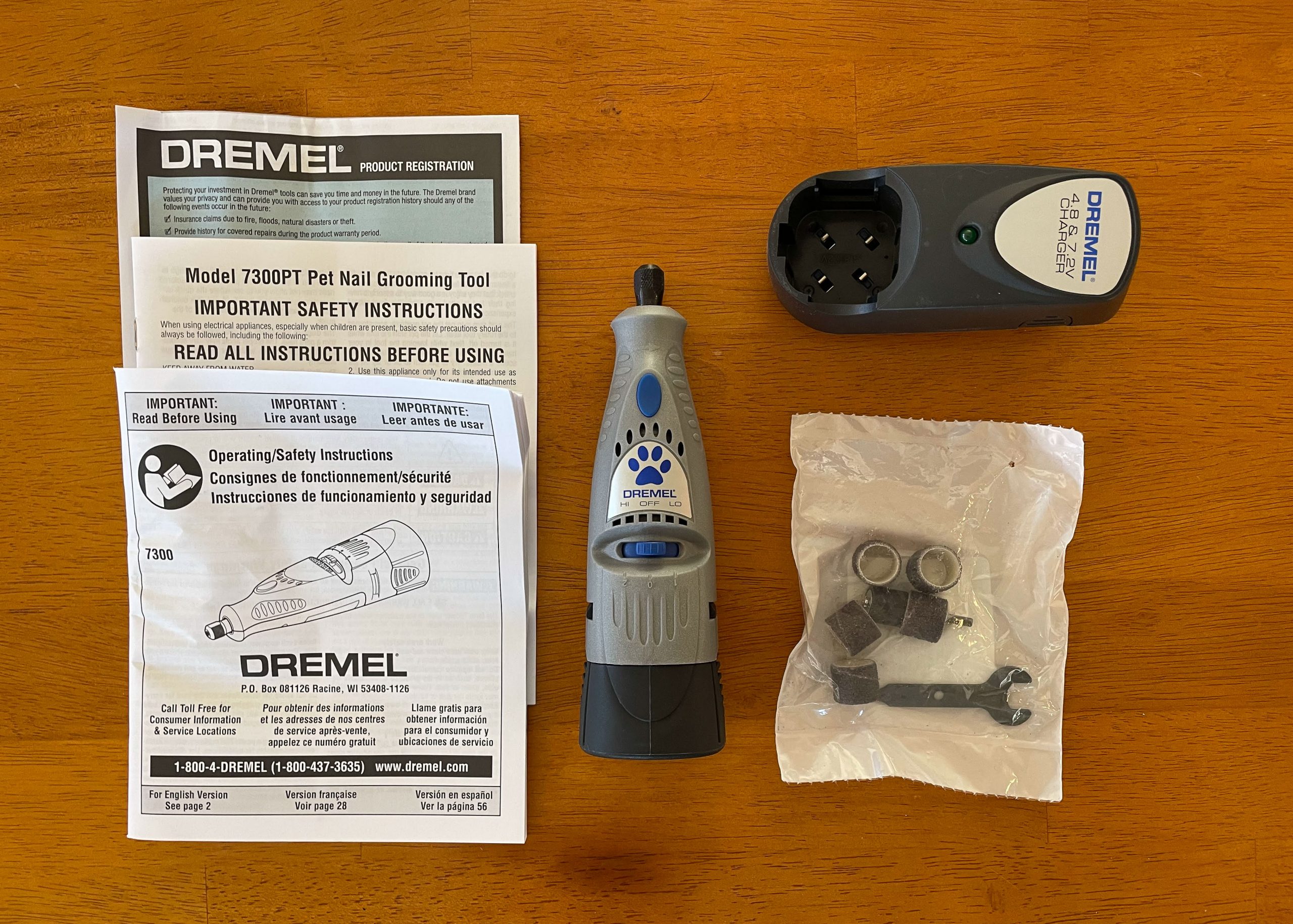
The contents of the Dremel 7300 Packaging.
Testing the Grinder
The Dremel 7300-PT is a cordless grinder, which I found to be essential. As soon as we called Logan over to try it out, he knew something was up, and he got a bit dodgy about it—not being tethered to a particular spot or having to deal with a cord was a huge benefit. It’s also small and light enough to be comfortable in the hand, allowing for good control.
Using the grinder still benefits from having two people around—one for comfort and the other to do the work. At first we only did one nail on the lower of the two speed settings. This gave both him and us a chance to get used to the device. The grinder is just as quiet as promised, and Logan was generally nonchalant about the whole thing, more annoyed that I was handling his paws than by the whirring device. I called his sister—the always-nervous Terrier—over for her own trial.
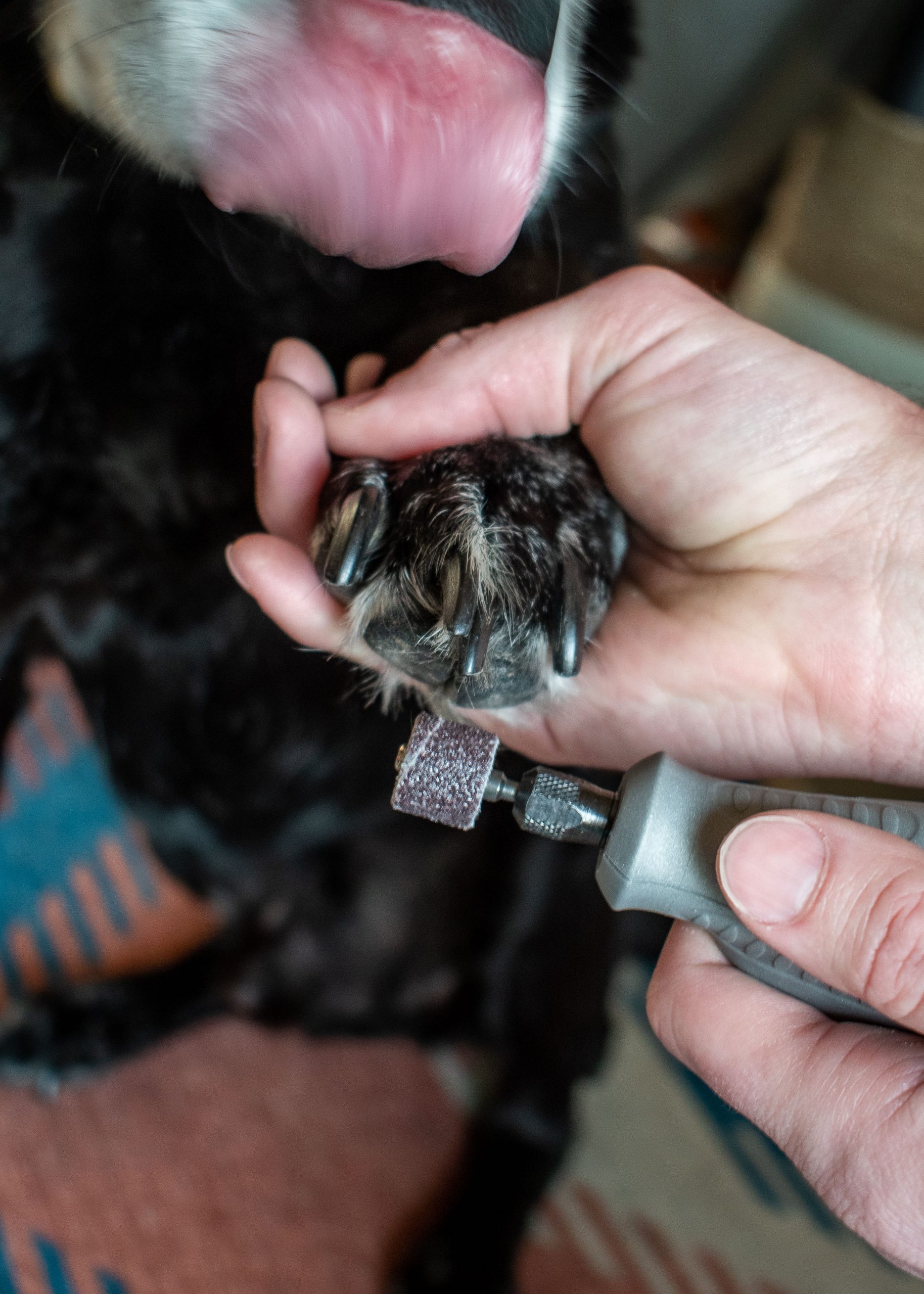
Grinding Logan’s nails.
Even Miss Bennet, who is usually scared of everything, generally seemed okay with the dog nail grinder. I’m not sure she’ll have the patience to let me do all of her nails, but that’s alright. At just 30 pounds, both she and her nails are easier to manage—and to get a clean chop—with clippers. Plus, most of her nails are white, save for one rogue black nail, so we can easily see and avoid the quick.
For Logan, though, I’m excited to use the grinder to keep his toes tidy. He has one extra-long dewclaw that I’m particularly ready to attack.
Absolutely. The 7300-PT Cordless Dog Nail Grinding Tool is an excellent alternative to traditional clippers, providing a safe and more comfortable nail trimming experience for dogs with thick nails, dark nails, or residual clipper trauma.
